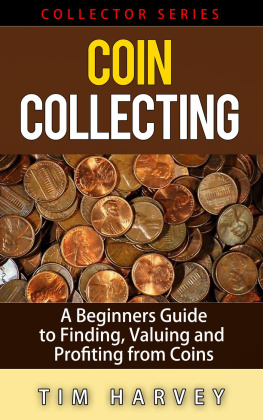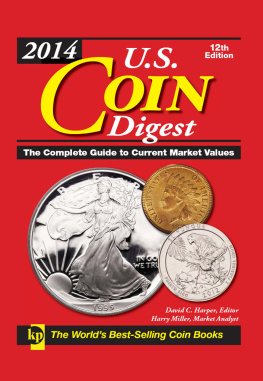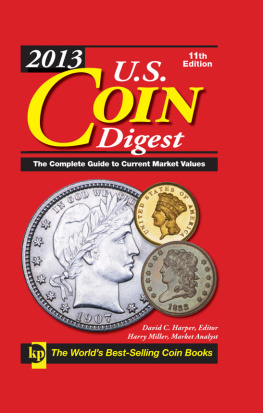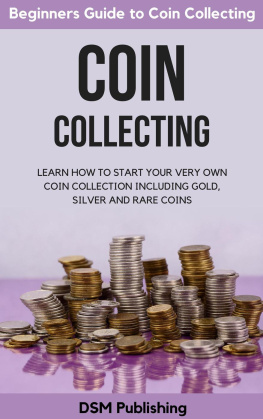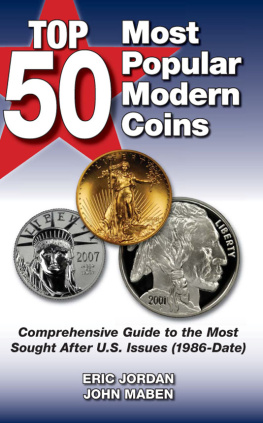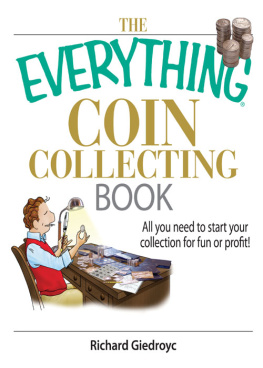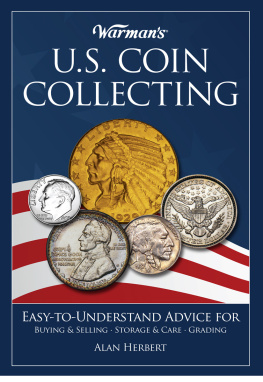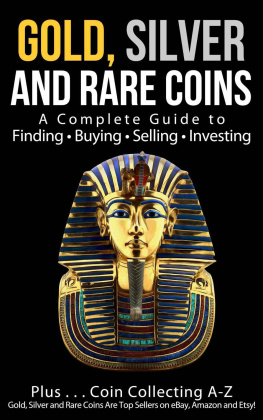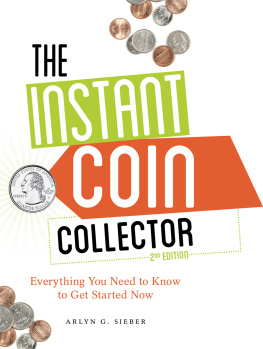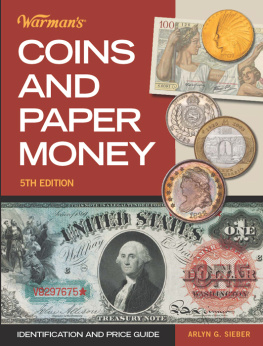Coin Collecting
A Beginners Guide to Finding, Valuing and Profiting from Coins
(Collector Series)
Published By Shaharm Publications

For a full list of books by Shaharm Publications, please go to: http://www.shaharmpublications.com
W hile every precaution has been taken in the preparation of this book, the publisher assumes no responsibility for errors or omissions, or for damages resulting from the use of the information contained herein.
C opyright 2015. All rights reserved worldwide. No part of this publication may be replicated, redistributed, or given away in any form without the prior written consent of the author/publisher.
Introduction
A coin collecting hobby is the practice of collecting or trading old or legally minted coins. Most collectible coins have been in circulation for a short time, for example, historically interesting coins or error coins. Although the term numismatics refers to the study of currency, it is closely related to coin collecting.
A coin collector is a person who mainly collects coins as a hobby or for investment purposes. Coin collectors are also known as numismatists which term, in a technical sense, refers to a person who not only collects but also studies coins and other currencies such as paper money, as well as tokens and medallions. Therefore, a numismatist may be a hobbyist, a serious collector, a dealer, or a scholar who studies coins as part of a sociology or history project for example.
During the medieval ages, coin collecting was confined to the nobility, such as popes and kings, as well as royal family members, as they were the only people who could afford to collect coins. According to coin collecting history, the first known collector of coins was the Roman Emperor, Caesar Augustus, who was fond of collecting foreign and old coins which he gifted to visitors and friends during festivities and special occasions.
Coin collecting has found its way into modern society and today almost anyone can become a numismatist. Coin collecting has generated an active numismatic market and, as interest has grown, coin collectors organizations and clubs have sprung up to satisfy the ever growing demand for this interesting pursuit.
Coin collectors can be categorized, broadly, into five different types of collectors:
1. Coin Collectors
M ost coin collectors collect coins as a hobby and, even though they are aware of the potential value of their collection, making a profit is not a top priority. They are more interested in the historical significance, artistic appeal, and sentimental value of coins.
2. Coin Investors
I n contrast to coin collectors, investors are more interested in the financial gain that their hobby can generate. They are keenly aware of coin market trends and will purchase, trade and sell coins accordingly. The historical significance and other trademarks of coins matter only in that they may increase the value of the coins.
3. Commercial Coin Buyers
A bove everything else, commercial coin collectors are concerned with the melt value and bullion value of coins. Their main purpose is to collect and sell bullion coins, such as gold and silver coins, for commercial use. These coins are melted for use as components in products such as jewelry and other commercial products.
4. Coin Inheritors
P ersons who possess coins that they have inherited from numismatist relatives, ancestors or friends may choose to grow their collection and become numismatists themselves, or they may decide to keep the coins as an heirloom to pass on to their children. Inherited collections are sometimes donated to coin museums.
5. Coin hoarders
T he coin hoarders involvement in coin collecting is distinctly defined by the opportunity to haphazardly collect and possess large numbers of unsorted coins. A hoarder seldom has any interest in the historic value of coins or the potential for financial gain.
In this guide to coin collecting for the beginner, we will focus on coin collecting as a hobby that can also generate financial gain. With a healthy interest and a certain amount of knowledge, coin collecting can become a lucrative hobby.
HISTORY
A Brief History of Coin Collecting and the Beginnings of Numismatics
C oin collecting, known as The King of Hobbies or The Hobby of Kings, is considered to be the oldest hobby in the world as coin collectors existed in ancient times. The first person known to be connected to coin collecting was Caesar Augustus, the Emperor of Rome, who handed out old foreign coins at festivals to guests and friends. His interest in coin collecting was passed on to his successors who continued the practice of collecting coins after his death.
Coins were not only used for monetary exchange, but also as accessories, notable in jewelry. In the period 400 - 300 BC, coins were considered to be works of art and pieces worth collecting. Coins were the most transportable and affordable forms of owning art and most members of the nobility possessed coins cast in precious metals such as gold and silver. A series of coins were issued by the Roman Mint during 251 - 249 BC to pay tribute to the Emperors of Rome, including Severus Alexander and Caesar Augustus.
Coin Collecting During the Medieval Ages and the Renaissance
D uring the 14th Century coin collecting became popular among the nobility, popes and European monarchs, including Pope Boniface VIII, Louis XIV in France, and in Brandenburg, the Elector Joachim II.
When interest in coins evolved into a scholarly pursuit, academic studies were undertaken where coins were used as a tool to trace the history of monetary systems in ancient trading. During this period the practice of listing and classifying coins by different types and ages developed.
Coin Collecting in Modern Times
T he American Numismatic Society was founded in 1858 and in 1891 it was followed by the establishment of the American Numismatic Association. Books, newspapers and magazines covering the collection of coins were published and distributed and became extremely popular among numismatists.
Numismatics continued to grow until the 20th Century when coin collecting advanced from collecting ordinary pocket change coins to a variety of interesting collectible coins that entered the coin market.
Coins such as proof coins, commemorative coins, and error coins captured the interest of coin collectors and a new coin collecting category started. Error coins are coins with striking errors or mint mistakes that are not released for circulation, but have become popular as collectible items among numismatists.
In 1962 the Royal Canadian Numismatic Association and the American Numismatic Association sponsored the first International Convention for Numismatists in Detroit, Michigan which was attended by about 40,000 people.
Buying, selling and trading of collectible coins became more prevalent and during the 1970s, and large numbers of coin investors entered the collectible coin market. During this period the economy became extremely unstable and investors warned of inflation. Since most collectible coins were gold or silver, collectors soon learnt how to profit from coin collecting as bullion and precious metal coins immediately became tangible and sound investments.
Fake Coins
T he tremendous growth of coin collecting attracted fraudulent transactions from those who saw an opportunity to make money out of fake coins. Ancient coins in particular were used in counterfeit schemes due to their value and popularity in the coin collecting market. In order to counteract this threat, coin grading and authentication institutions had to be established to evaluate coins for the protection of the market and collectors.
Next page
